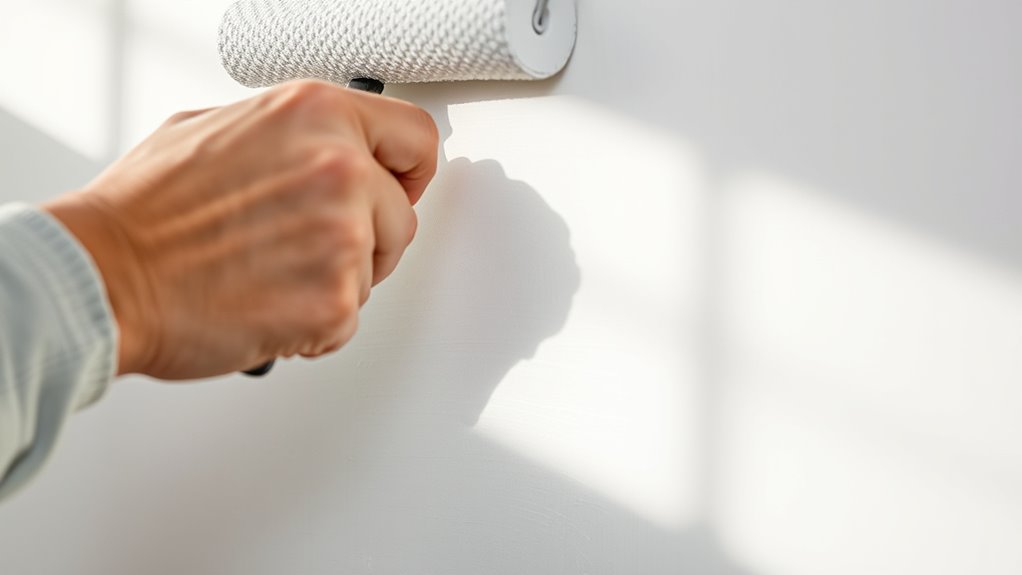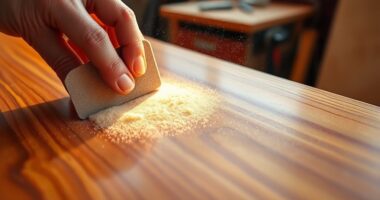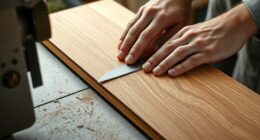To achieve a smooth finish with a roller and back-brushing, start by loading your roller evenly and applying paint in a “W” or “M” pattern to distribute it uniformly. Use light pressure and let the roller do the work, then go over the area with back-brushing using a brush to smooth out roller marks and push paint into the surface. Consistently maintain good paint consistency and technique throughout. Keep practicing these steps, and you’ll master the art of flawless, professional results.
Key Takeaways
- Load the roller evenly and use a “W” or “M” pattern to distribute paint smoothly.
- Maintain proper paint consistency—creamy and lump-free—for easier application and blending.
- Use gentle, controlled strokes with a roller to prevent streaks and ensure even coverage.
- Back-brush over rolled areas with a brush to eliminate marks and enhance surface uniformity.
- Keep practicing consistent technique and attention to detail for a polished, professional finish.

Painting with a roller and back-brushing is an effective way to achieve a smooth, professional finish on walls and ceilings. To do this successfully, mastering your brush technique and understanding paint consistency are essential. When you start, focus on your brush technique by using smooth, controlled strokes. Hold the brush comfortably and apply even pressure to avoid streaks or uneven coverage. The goal is to lay down the paint evenly, which creates a uniform surface that the roller can then blend seamlessly. As you work, remember to keep your brush loaded with just the right amount of paint—too much can cause drips, while too little may leave gaps. Proper paint application methods are crucial for achieving a flawless look.
Paint consistency plays a crucial role in achieving a flawless finish. You want your paint to be smooth and free of lumps or overly thick clumps, which can hinder your brush technique. If your paint is too thick, it’s harder to spread evenly, and the brush may leave streaks. Conversely, if it’s too thin, you risk drips and uneven coloration. Adjust the paint’s consistency by adding a small amount of water or paint conditioner if necessary, and mix thoroughly until you reach a smooth, creamy texture. This consistency allows for easier application and better control during back-brushing, which is key to eliminating roller marks and creating a polished look.
When applying paint with a roller, start by loading it evenly and rolling it onto the wall in a “W” or “M” pattern to distribute the paint. Don’t press too hard; let the roller do the work. As you work, periodically back-brush—go over the freshly rolled area with a brush to smooth out any imperfections. This back-brushing technique improves adhesion and pushes the paint into the surface, filling in gaps and creating a seamless finish. Use your brush with a gentle, consistent motion, ensuring that you blend the edges smoothly without leaving streaks or marks.
Throughout the process, maintaining the right paint consistency and employing a proper brush technique are your best tools for success. They help you control the application, avoid drips, and achieve an even, professional-looking surface. With patience and practice, you’ll find that these steps considerably improve your results, making your walls look flawless and beautifully finished. Remember, the key is in the details—use proper brush technique and keep your paint at the right consistency, and you’ll end up with a finish that’s smooth, durable, and visually appealing.
Frequently Asked Questions
Can I Use a Roller on Textured Walls?
Yes, you can use a roller on textured walls, but it depends on the wall texture. For rough or heavily textured surfaces, choose a roller with a thick nap to reach into crevices. Use specific roller techniques, like gentle rolling and overlapping, to make certain of even coverage. Keep in mind that using a roller on textured walls may highlight the texture instead of hiding it, so select your roller type accordingly for the best results.
What Type of Paint Is Best for Back-Brushing?
For back-brushing, choose a high-quality, semi-gloss or satin paint with a smooth, consistent texture. This helps you achieve an even finish and reduces streaks. Make sure the paint has the right consistency—not too thick or runny—to ease application. Also, consider the drying time; a faster-drying paint allows you to work efficiently and check your work sooner, ensuring a sleek, professional look.
How Do I Prevent Roller Streaks?
To prevent roller streaks, you should focus on your brush technique and control your roller pressure. Use a light, even pressure when rolling, and avoid pressing too hard. Maintain a wet edge by overlapping each stroke slightly and work in small sections. After rolling, go over the area with a brush or roller to blend streaks. Proper technique and consistent pressure help achieve a smooth, streak-free finish.
Is Back-Brushing Necessary for All Paint Types?
Back-brushing isn’t necessary for all paint types, but it’s highly recommended when working with certain paint sheens like semi-gloss or high-gloss, which tend to show streaks more. If you’re using a quality paint primer and choosing the right sheen, back-brushing helps smooth out roller marks and guarantees an even finish. For flat or matte paints, it’s less critical but can still improve the overall look.
How Do I Clean Roller Brushes Properly?
Think of your roller brushes as loyal tools that deserve care. To clean brushes properly, rinse them thoroughly with water or solvent, depending on your paint type. Use a brush comb or fingers to remove excess paint, then spin or shake out remaining moisture. Store brushes with the bristles upright or hanging to maintain their shape. Proper cleaning and storage tips ensure your brushes stay in top condition, ready for your next project.
Conclusion
Now that you’ve mastered rolling and back-brushing, your walls will look as smooth as a Renaissance masterpiece. Remember, patience and proper technique are key—think of it as your own Da Vinci’s touch. Don’t rush the process; even Michelangelo took time to perfect his sculptures. With these tips, your paint job will be flawless, and you’ll be proud of your work. So grab that brush, channel your inner artist, and transform your space into a work of art.









